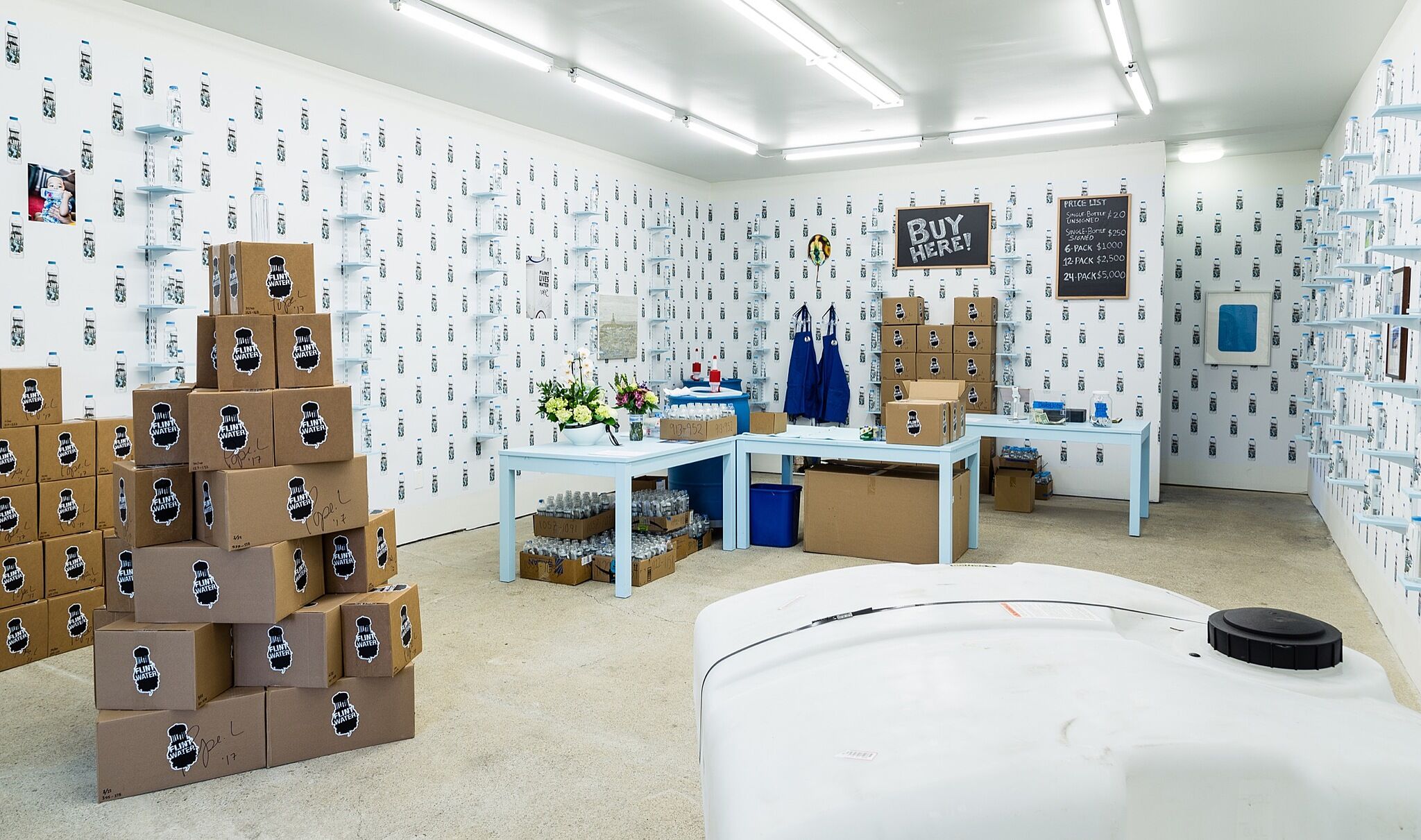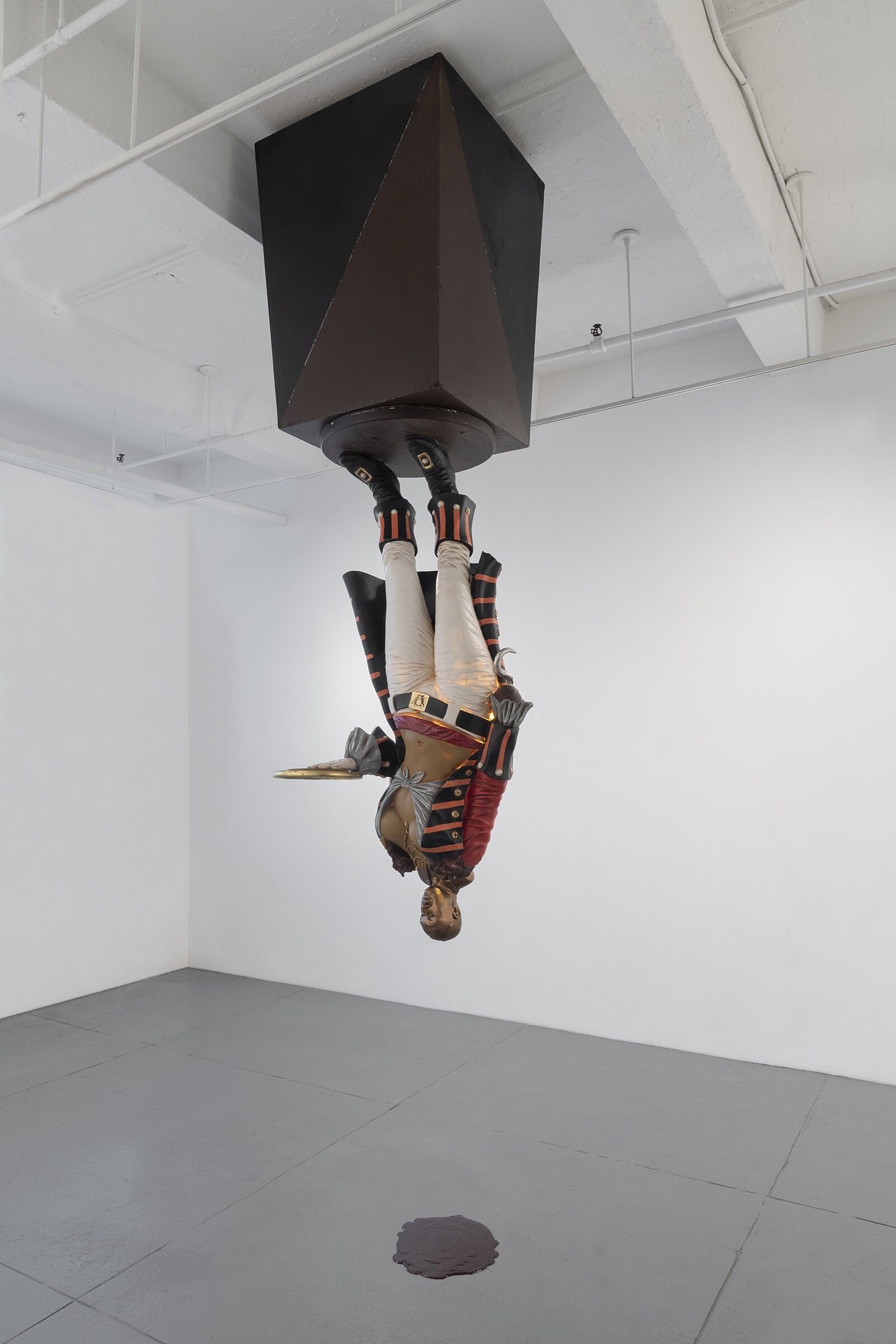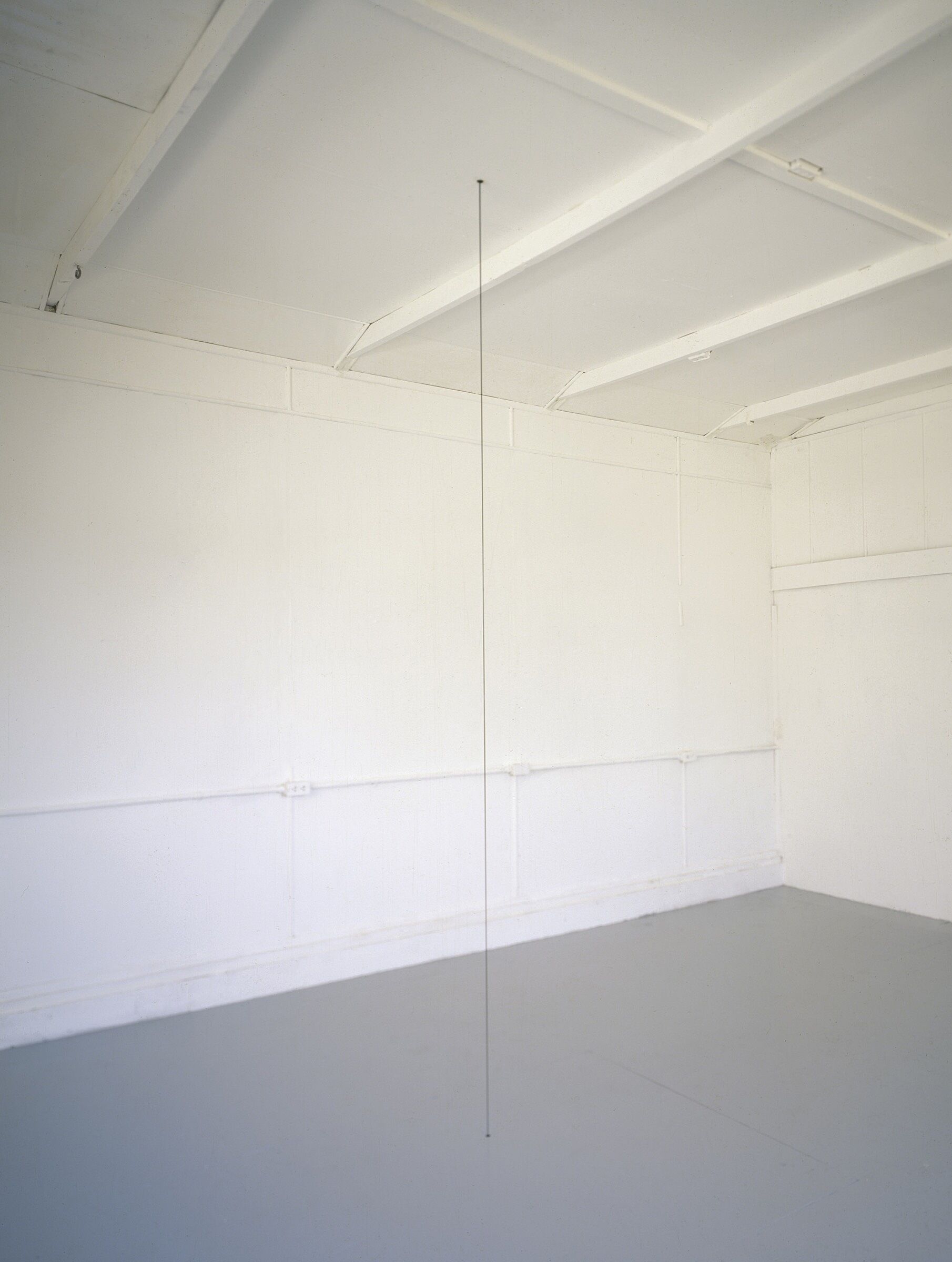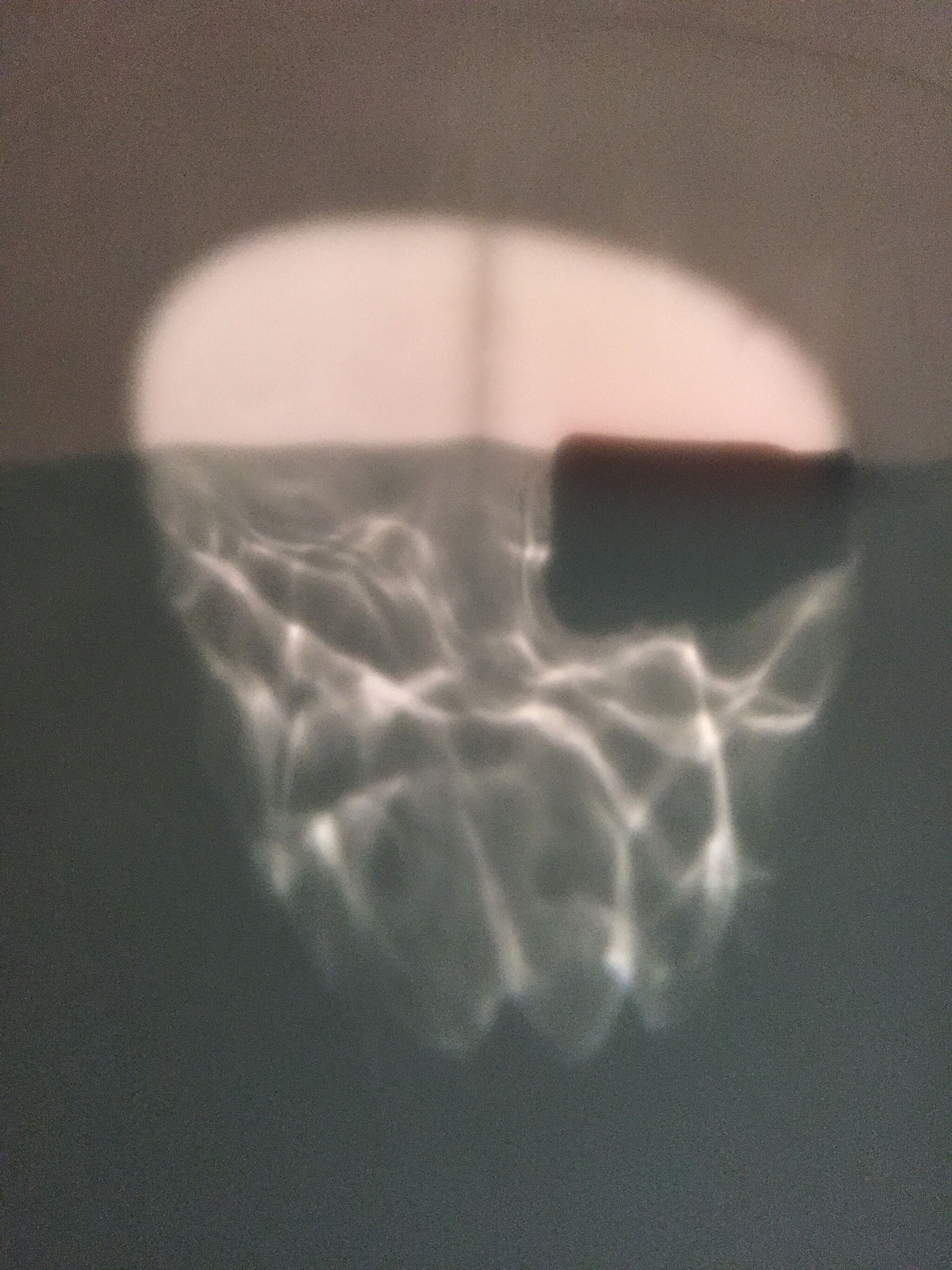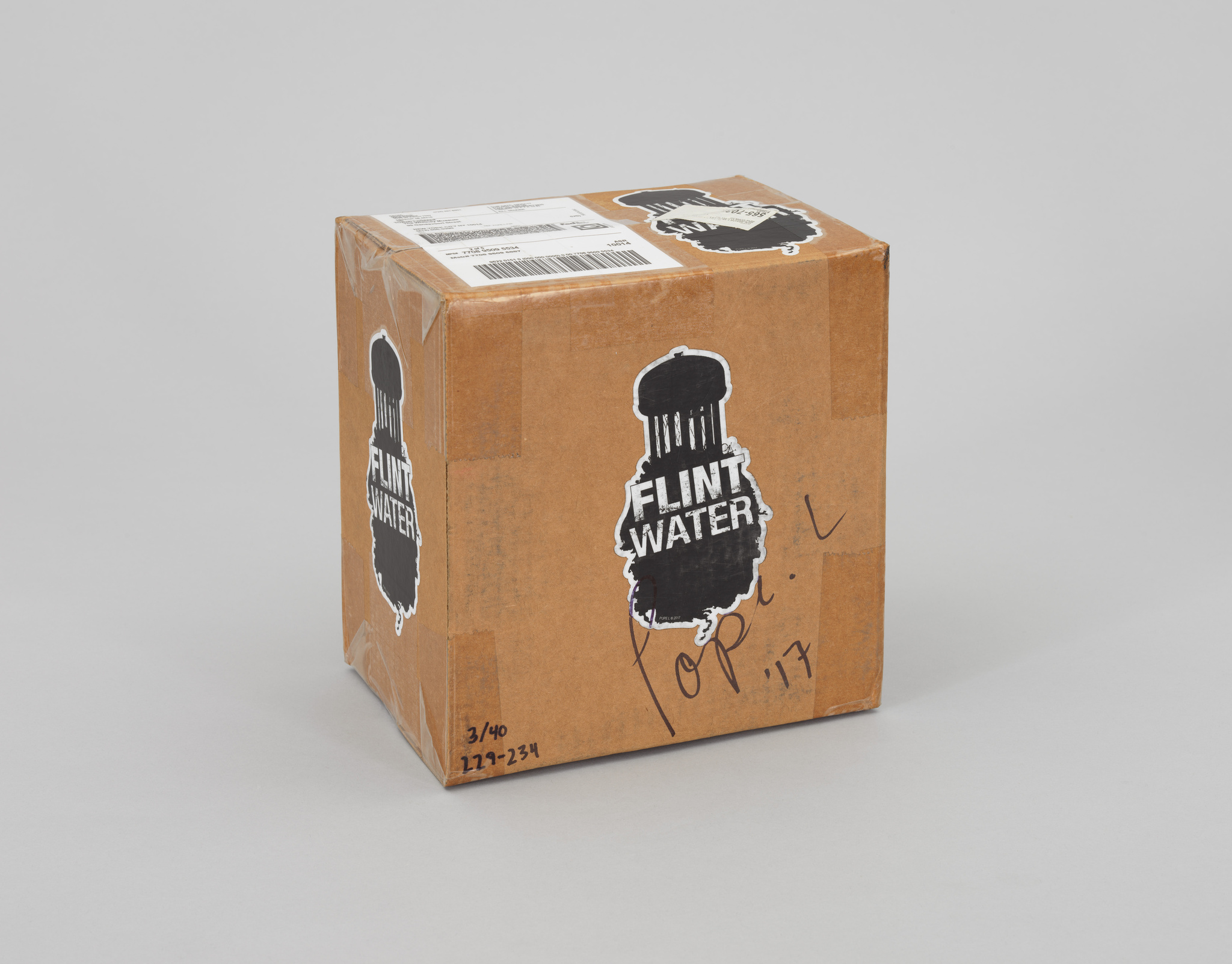Something from Nothing: On Pope.L’s Choir and Other Waters
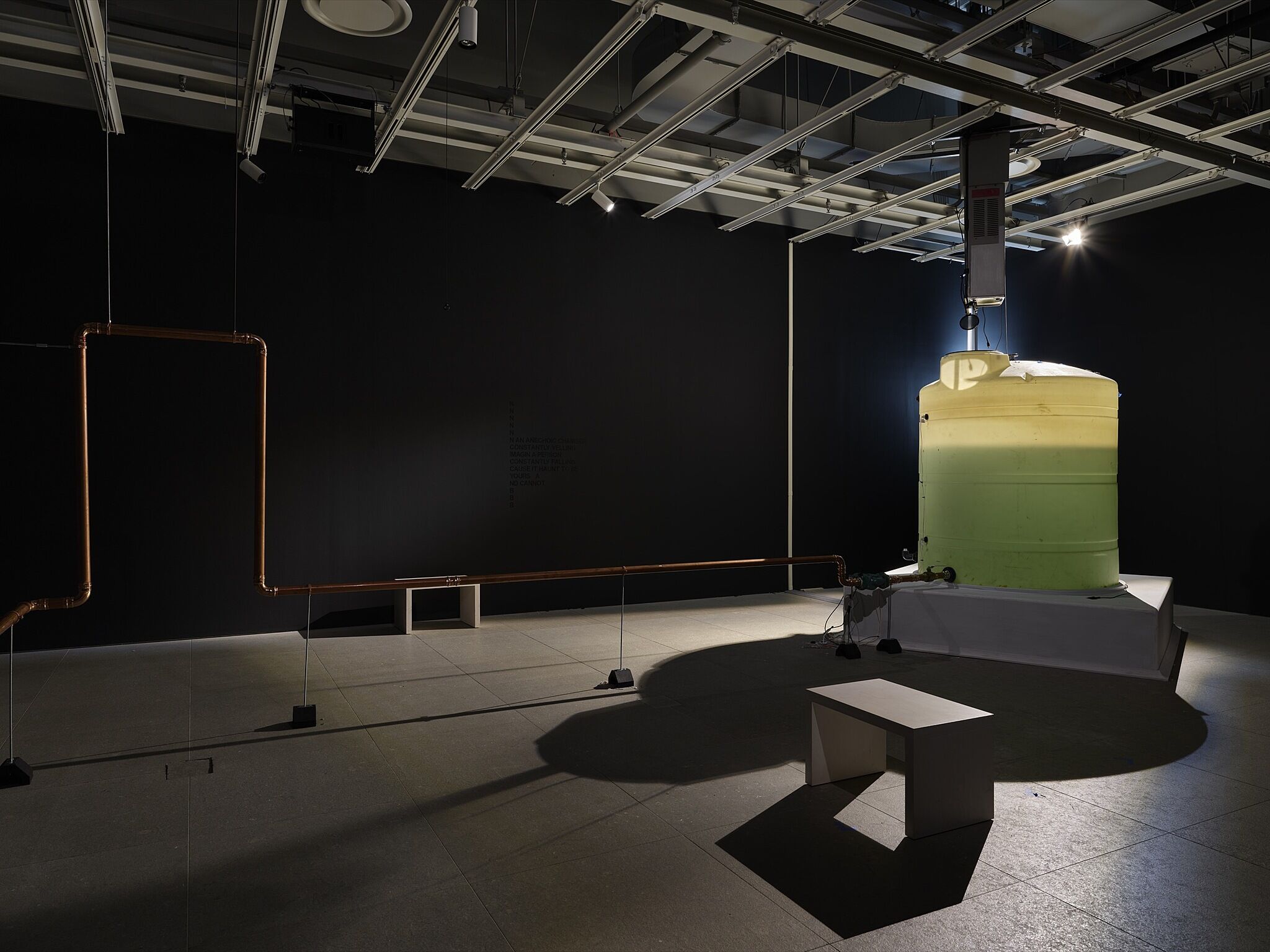
Pope.L, Choir, 2019 (installation view, Pope.L: Choir, Whitney Museum of American Art, New York, October 10, 2019–March 8, 2020). Thousand-gallon plastic water-storage tank, water, drinking fountain, copper pipes, solenoid valves, pumps, MIDI controllers, electronic timer module, level-detection probe, flow meters, programmable logic controller, wood, scrim, vinyl letters, graphite, microphones, speakers, wires, and sound, dimensions variable. Collection of the artist; courtesy Mitchell-Innes & Nash, New York. © Pope.L. Photograph by Ron Amstutz

With little fanfare, a short video appeared on the web page for Pope.L’s Whitney exhibition in the month before its opening. It is dusk: Pope.L dons a khaki trench coat and stands on a pier along Manhattan’s West Side, looking out at the Hudson River. He surveys the scene and then pours the contents of a plastic water bottle over the railing into the river. Water spills forth, and keeps flowing and flowing. As darkness grows, the pour continues from a seemingly bottomless bottle; we glimpse that it is labeled Flint Water, as if an invisible pipe connected the contaminated water of Flint, Michigan, to the plastic container in Pope.L’s hand.
This seemingly ludicrous action recalls the slapstick comedy of Buster Keaton and Charlie Chaplin, as well as Lucille Ball’s hilarious attempt—with partner-in-crime Vivian Vance—to wrap chocolates speeding along a factory conveyor belt in an episode of I Love Lucy. While Lucy and Ethel work furiously to keep up with the mechanized pace, wrapping faster and faster and then resorting to stuffing the chocolates into their shirts, mouths, and hairnets, Pope.L remains stoic. Rather than stop the flow by collecting or ingesting it, he acts as a conduit, allowing it to pass through. By extending the duration of his gesture, Pope.L nods toward physical comedy. In what he describes as “Flint water meets the mighty Hudson,” he uses the improbability of the act to slyly echo the dire absurdity of the water crisis in Flint and elsewhere.As this essay was written, news broke of the lead contamination found in the drinking water in Pope.L’s hometown of Newark, New Jersey. See Nick Corasaniti, Corey Kilgannon, and John Schwartz, “Tainted Water, Ignored Warnings and a Boss with a Criminal Past,” New York Times, August 21, 2019. In Michigan, it was a fully preventable problem. Inept state and local governments, whose actions were potentially criminal,Mitch Smith, “Flint Water Prosecutors Drop Criminal Charges, With Plans to Keep Investigating,” New York Times, June 13, 2019.attempted to save money in 2014 by drawing the city’s drinking water from the Flint River rather than Lake Huron.CNN Library, “Flint Water Crisis Fast Facts,” updated July 2, 2019.With the switch, levels of lead, coliform bacteria and other pathogens, and toxins spiked to dangerous levels in the water. In a country so rich in so many ways, it is shameful that the government endangered its own people. While Flint’s population is primarily poor and Black, Pope.L sees the issue of safe water as one that cuts across race. Even so, it could be argued that this is yet another instance in the long arc of injustices enacted upon the impoverished and people of color.
In 2017 Pope.L addressed the crisis directly through his Flint Water project at What Pipeline in Detroit. He collected tap water from a home in Flint and brought it to the gallery, which had been transformed into an installation that functioned as a bottling factory, laboratory, pop-up shop, and group exhibition all at once. The gallery sold the Flint water as individual bottles and in boxed sets as an art multiple. In what Pope.L describes as “one distressed city helping another,” all of the proceeds were donated to the United Way in Flint and other local nonprofit organizations. By “returning” Flint water to the Hudson in his video, Pope.L shifts the perspective and scale. What seems to be an endless supply of water from a bottle is still insignificant when compared to the river into which it flows, and yet Pope.L demonstrates that there is no safe scale when it comes to pernicious social problems.
As an artist who professes to use “lack” as material, Pope.L has, for decades, found a way to utilize what is readily at hand to create transformational works. He has often incorporated cheap foodstuffs like hot dogs, peanut butter, and bologna into his work. In Choir, his new installation made following his receipt of the Bucksbaum Award for his contribution to the 2017 Whitney Biennial, Pope.L uses common construction materials and appliances—copper piping, an old drinking fountain, and a massive repurposed plastic storage tank—to create a work that is always in flux, constantly filling with, draining, and circulating water (itself an everyday resource that is often taken for granted). In his poetic ruminations on Blackness he once said, “Blackness is one true thing defined as lack.”Pope.L, “Some Notes on the Ocean,” in William Pope.L: some things you can do with blackness (London: Kenny Schachter Rove, 2005), 4.So much has been withheld from Black people throughout American history and in the present day—essential humanity, basic rights, suffrage, opportunity, and even life itself. And yet for Pope.L—an artist who moves toward the complex and absurd—this idea of lack, or absence, is something to have and to hold, something to make use of. Pope.L’s work knowingly toes the line of discomfort. As Nato Thompson writes, Pope.L’s aim “is not to comfort but instead let the confusion hover, and, in that space of ambiguity, provide an ‘opportunity’ of escape.”Nato Thompson, “The Black Chocolate Factory,” in William Pope.L: some things you can do with blackness (London: Kenny Schachter Rove, 2005), 27.That chance of escape is often offered through a seeming non sequitur or disparate element, such as the bottle of “Mad Dog” 20/20 fortified wine in his 2017 Whitney Biennial work Claim (Whitney Version) that the artist left open, with the intention that it would seep into the pores of museum-goers.
Physically, Choir is centered on an absence. After walking through a corridor formed by black mesh fabric and turning a corner, the viewer is hit with a bright light, illuminating from behind a milky white 1,000-gallon tank that sits high on a platform. The tank is weighty and marred by use, as much a void as a container. Haloed by the gallery lights, it achieves a certain monumentality. Directly above the tank, an old drinking fountain is suspended upside down from the ceiling. The fountain gushes at a volume and rate that surpasses normal capacity, sending water straight down into the mouth of the tank below. As if it could fill—or overfill—the tank, the intensity of the flow is matched by the amplified sound of the cascade. It reverberates loudly within the gallery and into the Whitney’s lobby just beyond the doors. Buried in the sonic maelstrom are sounds of singing and shouting, voices that at first are indistinguishable from the rush of water but later grow in presence and volume. Then, as quickly as it began, the fountain stops, letting the water lap the sides of the tank, the waves visible through the semitranslucent plastic. A moment later, a pump kicks on—its mechanic whir also picked up by the microphones installed in the gallery—and the water drains from the tank through a network of copper pipes that run throughout the space. The cycle repeats like a delirious ritual revolving around the tank; there is a constant movement and flow, an alternating presence and absence of abundance. The tank is a void that is filled with a roar, only to be pumped out and replenished again in a Sisyphean act—not unlike Lucy’s futile attempt to stave off the flow of candies.
As one’s eyes adjust to the dim light of the darkest corners of the installation, subtle vinyl texts on the dark gray walls become noticeable. Clipped and fragmented, the provocative texts, in part, seem to point to the drinking fountain as a device used to uphold segregation in mid-twentieth-century America: “NGGR WATER,” “HLLOW WTR,” “NDVSBL WTR.” Paired fountains throughout the South during the Jim Crow era made clear that the doctrine of “separate but equal” was really a way to maintain white supremacy in all aspects of life. Each sip from a public water fountain was a reminder of one’s position relative to racial apartheid. Pope.L’s texts serve as a reminder of this moment in U.S. history but also ask the viewer to slow down and parse the abbreviated language. And they allow Pope.L to draw from other histories and narratives. In the longest text in the installation, he refers to the anechoic chamber—a room designed to be completely silent—in which artist and composer John Cage said he could hear the sound of his own circulatory system; it alludes to lines from poet John Ashbery and civil rights leader Malcolm X as well.
Choir is not the first work by Pope.L to use moving liquids, fountains, and their ilk. His Chocolate Fountain (2005) featured holes in the gallery walls through which chocolate is pumped, oozing down and puddling on the floor. As Elizabeth Bard describes it: “The pristine surface of the gallery wall, hardened by decades of ideological and architectural convention, has suddenly sprung a leak. Out pours chocolate, the sweetest kind of blackness. It is non-threatening,Pope.L once dubbed himself the friendliest Black artist in America. See Mark H. C. Bessire, ed., William Pope.L: The Friendliest Black Artist in America© (Cambridge, MA: The MIT Press, 2002).but it is there—and it has the tendency to stick.”Elizabeth Bard, “The Candy Man Can,” in William Pope.L: some things you can do with blackness (London: Kenny Schachter Rove, 2005), 8.In a related drawing from 2004, Pope.L gnomically annotates and strikes through this sentence: “An architecture conjecture that of want taunts haunts not just effects.” The fragmentary proposal is apt for nearly all of his fountain works. Three years later, Pope.L would append a bust of Martin Luther King Jr. to the body of a female mannequin he described as a “pirate serving wench”—and like the Choir fountain—flip it upside down and attach it to the ceiling. This is A Vessel in a Vessel in a Vessel and So On (2007) and from the top (now the bottom?) of King’s head drips chocolate syrup, collecting like a black hole on the floor. Similarly, Pedestal (2017) features an upside-down, midcentury drinking fountain that releases a trickle of water every few minutes as determined by a darkroom timer. The water does not collect, but rather disappears silently into a literal hole in the floor. What had puddled and collected to form a sweet-smelling black mirror in previous works becomes a kind of vacuum that absorbs not only liquid but also sound.
Employing the black hole as a trope to examine the work of author Richard Wright, scholar Houston A. Baker Jr. says, “Transliterated in letters of Afro-America, the black hole assumes the subsurface force of the Black underground. It graphs, that is to say, the subterranean hole where the trickster has his ludic, deconstructive being. Further, in the script of Afro-America, the hole is the domain of Wholeness, an achieved relationality of Black community in which desire recollects experience and sends it forth as blues.”Houston A. Baker Jr., “A Dream of American Form: Fictive Discourse, Black (W)holes, and a Blues Book Most Excellent,” in Blues, Ideology, and Afro-American Literature: A Vernacular Theory (Chicago: University of Chicago Press, 1984), 151.Baker delves into astrophysics to find a new reading of Wright’s work. The hole serves as a momentary refuge for the so-called trickster to conjure “a language that connotes a world of transience, instability, hard luck, brutalizing work, lost love, minimal security, and enduring human wit and resourcefulness in the face of disaster.”Ibid., 188.The white hole in Choir is activated through its attempted filling, which also triggers sonic effects. The installation incorporates 1930s gospel recordings in addition to bluesy field shouts—audio pieces imbued with a sense of pride and hope set against all odds—but they have been rendered nearly unintelligible by altering the samples and mixing them with gurgling sonic effects and distortion, all of which washes over and pervades the live din of the water as it collects before it is suddenly evacuated. Formal inversions abound: black into white; the upright drinking fountain flipped (effectively turning on its head the segregationist policies that a fountain of a certain period is associated with); and, in terms of owning one’s lack, something from nothing.
Pope.L sees Choir as an experiment. He has carefully planned out the materials and equipment, their look and finish, as well as the sequence of the work’s physical and audio events. And yet, even he cannot fully anticipate the effect of the combination of all of the components. He likens the sound of the work to the noise and distortion of punk music as well as to the church services of his youth, in which trained and untrained voices came together in song. Pope.L could hear the congregation as a communal whole, but he also recalls his aunt singing distinctly next to him, someone off-key elsewhere in the pews, the robed choir on stage. Speaking about performance and the church, Pope.L says, “The choir comes in at certain points; people in the audience jump out of their seats and talk in tongues, sound surrounds, enters you. There’s all of this, foaming, ranting, and cacophony. Joyous noise.”See Martha Wilson, “William Pope.L,” Bomb 55, April 1, 1996. A noise that he calls “wobbly”—in concert but not unified. As one moves throughout Choir, different audio elements come to the fore, a gospel voice in one corner, a liquid clamor when approaching the tank. The work is constantly changing physically and aurally: water moves through the pipes and into the tank, sounds emerge and submerge, and recorded sounds of dripping water ring through even when everything seems to have stopped.
Choir recalls another contemporary work that applies a similar material but to a dramatically different end. Charles Ray’s Ink Line (1987) is a subtle installation in which a thin zip of ink flows from a tiny aperture in the ceiling down to the floor where it drains invisibly. The equipment pumping the ink is hidden, and the viewer is left with a black column that appears static. Upon closer inspection, fluctuations can be seen in the flowing liquid. Ray makes moving ink appear as inert sculpture, while Pope.L seeks to make ever-changing art of moving water. Pope.L’s work emphasizes the nature of liquid, the physical state in which the material “wants” to spread everywhere. Ink Line, in contrast, closes down the work’s material properties, conforming it to a vertical orientation. This reining in of the unpredictable nature of liquid becomes a source of tension. As John Kelsey writes of Ray’s work, “The idea of spilling is always present even when nothing spills.”John Kelsey, Charles Ray (New York: Matthew Marks Gallery, 2010), 59.Ink Line is an anxious work of self-containment, whereas Choir is a kind of allover composition in which water and sound spill repeatedly. Landing somewhere in between these two works is Pope.L’s Well (Whitney version), which he describes as “a much quieter, more laidback version of Choir” placed in ten locations throughout the Museum.Pope.L, email message to author, June 6, 2019.In contrast to the larger installation’s constant movement, Well functions as potential energy—a drinking glass filled with water sitting on a high shelf or on a countertop, available but not yet consumed. Well is a minimalist piece made through subtraction; Choir is maximal and pervasive.
As allover as Choir is, though, where is it? What is it? A fountain alluding to Jim Crow–era segregation empties into the open maw of a white hole that is never truly filled. Pope.L describes the experience of Choir as a “tumult-space”: “There is the violence or discomfort or disorientation regarding de-figuring, de-sensing one’s way out (in order) to merely survive and then to figure out the puzzle which is the work.”Pope.L, email message to author, August 2, 2019.The contraption gushes and sputters, drones and drips, points in its own tangential way to the fragility of our natural resources, and we—as viewers of the work—are left like Lucy and Ethel: mouths agape, keeping up with the flow until we can’t.
